- Overview
- Full Itinerary
- Photo Gallery
- Costing
- Travel Details
- Trip Reports
- Guide
- Map
- Know Before You Go
- Other Trips You May Like
Embark on a true African safari to Botswana and neighboring Namibia, where the wildlife is pristine, and our days are timed with the rhythm of nature. Southern Africa is visually exciting—each of its unique habitats have distinct features, most famous of which are the expansive Okavango Delta and stunning red dunes at Sossusvlei. This year for the Botswana portion of our safari, we feature tented safari camps that are two of our founder, Peg Abbott’s, favorites—places that have consistent sightings of Wild Dog, Leopard, Lion, and Cheetah in addition to habitat variety for great birding and some wonderful creature comforts that create a most memorable stay.
Find numerous Elephant along with Zebra, Warthog, Giraffe, various antelopes, and impressive birds including Southern Ground Hornbill, Secretarybird, Southern Carmine Bee-eater, Malachite Kingfisher, and Lilac-breasted Roller, all classic birds of Africa, as well as regional specialty species like Slaty Egret, Wattled Crane, Kori Bustard, Pel’s Fishing Owl, and possibly White-backed Night-Heron in Botswana, and Rosy-faced Lovebird, Monteiro’s Hornbill, Dune Lark, Herrero Chat, and Rockrunner to name a few.
From Maun, Botswana, we fly from camp to camp, saving long drives and giving us fabulous views of the Delta. The two camps provide a contrast, and as large mammals move around, give us the best chance possible of seeing predators. Both camps are outside of Moremi National Park, though ecologically linked to it, which enables us to do night drives, giving us a chance to find species such as Aardwolf, Bat-eared Fox, and other elusive species. Activity at the famous Gadikwe Lagoon rookery for Yellow-billed Stork, Marabou, and various herons is at a peak; we visit by boat from Kwara for a spectacular highlight and excellent photography!
We then fly from Maun to Windhoek to continue our journey with an incredible circuit in Namibia, exploring some of the most stunning arid-land scenery in Africa from lovely lodges, and then spending in-depth time in renowned Etosha National Park. Find additional species here from the stately Oryx to abundant Springbok, coastal and desert regional specialty birds and strange and legendary plants like the giant Welwitschia.
If big game, southern constellations, a rainbow of colorful African birds, and the enchanting sounds of wild Africa beckon, our Botswana-Namibia journey across two countries of Southern Africa is sure to entice.




Tour Highlights
- Experience the Namib, the world’s oldest desert, famous for massive red dunes at Sossusvlei
- Look for signature birds like Rockrunner, Herero Chat, Hartlaub’s Spurfowl, and Dune Lark
- Walk amidst the granite outcrops of the Erongo Mountains, known for impressive wildlife, rock art, and over 200 species of birds
- See one of the most bizarre plants on the planet, the Welwitschia
- Watch exciting raptors such as African Black (Verreaux’s), Martial, and Booted Eagles, Black-chested Snake Eagle, Lanner and Peregrine Falcons, Rock Kestrel, and more
- Enjoy the colonial seaside town of Swakopmund and visit Etosha National Park
- Explore the Okavango Delta’s papyrus-lined channels and lagoons and legendary wetlands and Mopane forests of Moremi Game Reserve
- Look for Pel’s Fishing Owl, White-backed Night-Heron, colorful nesting bee-eaters, and Sitatunga along the Okavango River
- Live “National Geographic moments” in real time on each morning and afternoon game drive
- Find signature birds like Slaty Egret, Black Heron, African Openbill Stork, Hamerkop, African Fish Eagle, Southern Ground Hornbill, bustards, hoopoes, and of course, the stunning Lilac-breasted Roller
- Capture that ultimate African sunset—acacia tree, Giraffes, Leopard, and more




Trip Itinerary
Itineraries are guidelines; variations in itinerary may occur to account for weather, road conditions, closures, etc. and to maximize your experience.
Fri., Sept. 27 : Morning Arrival to Maun, Botswana | Flight to Kwara Camp
Welcome to Botswana! You are met at the airport, with a short time there to meet up to the staff from Kwando’s Kwara Camp who will help you check in for the charter flight today.
Today we fly from Maun airport to our first safari camp. It’s a scenic flight, a little over an hour, in a small aircraft designed to land on bush airstrips. There we meet our expert local guides in their rugged 4-wheel drive safari vehicles. They review safety guidelines, and we go to camp to settle in. Often, we enjoy afternoon tea with snacks before heading out for a game drive in the afternoon when activity is high.
Kwara Camp in the Kwara Private Reserve shares a 30-kilometer water boundary with Moremi Game Reserve, allowing free passage of all species. It is over 400,000 acres and hosts a fabulous mix of upland and wet habitats in a mosaic attractive to herds of Lechwe, Impala, and other antelopes.
Your “tents” are hardly that—they feel luxurious on their raised platforms, with antique furnishings, spacious inside bathrooms that include indoor and outdoor showers, and a private patio with view of a lagoon. Delightful cuisine is featured and at day’s end you can listen to night sounds from your large and comfortable bed. One could get used to this safari life!
Accommodations at Kwara Camp (B,L,D)
Sat., Sept. 28 - Mon., Sept. 30 : Three Full Safari Days from Kwara Lodge
Kwara Lodge is our base for the next three exciting days of exploring. We rise early to be out with the animals. We look first for predators that are easier to find at dawn and dusk; our guides are expert trackers and have often followed the resident Lion pride, African Wild Dog pack, or Cheetah family for months, such a help to our finding them. After assessing the action from the night before, we switch gears to watching other species, birds, and mammals. Our group all helps with spotting … we see so much! Roads go out from the lodge into different habitats, so every day is different, and we often feel that we are experiencing a National Geographic moment, one right after the other.
One morning, we enjoy a boat ride that takes us up to a quiet lagoon where an active heron rookery is exciting. We moor the boat and watch as stunning, Yellow-billed Stork and gangly Marabou fly back and forth. There are numerous other herons, cormorants, and ibis. We travel a channel to get there, and on the route, Malachite Kingfisher often perch in close view, their jewel tones just captivating. The Okavango region is not unlike our Everglades, a slow moving, major river system that allows water to fan out across the otherwise arid landscape, transforming it into a paradise for wildlife. It is the largest Ramsar designated site in the world, set up to protect globally important wetlands.
Do not be surprised if an Elephant feeds along the lakeshore as you take your after-lunch rest, or if Green Pigeon come to roost in the large shading tree. Camp is one of the few places you can walk safely, so it is fun to birdwatch as you come and go between your tent and the main dining area. There may be a roosting Pearl-spotted or Barred Owl, a dashing, Crimson-breasted Shrike, one of the snazzy African woodpeckers, or a mixed flock with some of the tree-dwelling species.
The food is healthy and delicious and yes, there are sweet treats for dessert and with your tea. Drinks are included and served at sunset out in the field if we wish (we often choose based on animal activity as this is also prime photo time) or once we return to camp. African sunsets are memorable; once we savor the sunset it is back to the lodge to freshen up and join a lovely gathering for cocktails or tea followed by dinner in the open-air tent or out under the stars.
One night we take a drive to find more elusive mammals and perhaps Verreaux’s Eagle or other owl species.
Accommodations at Kwara Lodge (B,L,D)
Tues., Oct. 1 : Flight to Lagoon Camp | Afternoon to Sunset Boat Trip
This morning we enjoy a last game drive out from Kwara for one more chance to see additional species. We then have brunch, freshen up, and pack up before heading to our next camp in the Linyanti part of the ecosystem. This is another great chance to see the Okavango Delta region from the air; it’s fun to spot herds of Elephant in the water or crossing between waterholes, big herds of African Buffalo, or Giraffe.
At a new camp, we continue the rhythm of safari; an early morning game drive, followed by a hearty brunch, and then time for a siesta, in-camp viewing, and photography or relaxing. Then, it’s an afternoon game drive or sunset boat cruise lasting until sunset. Dinner is after dark, under an airy tent with candlelight and stars and more delicious and varied entrees with fresh fruits and greens.
Accommodations at Lagoon Camp, Linyanti Channel (B,L,D)
Wed., Oct. 2 : Full Safari Day from Lagoon Camp along the Linyanti Channel
Lagoon Camp sits in a spectacular place where desert meets water. Landscapes reveal upland tracts of Mopane Forest set in a mosaic of open savanna amid papyrus-lined water channels, lagoons, and mature riverine forests. Aquatic animals and water birds abound, along with herds of plains game and predators. It has an amazing combination of vegetation types, animal species, and bird life. One of the treats is seeing Yellow-billed and Red-billed Hornbills calling from the crowns of trees. Birdlife abounds and there are babblers, shrikes, coucals, rollers, barbets, and the gaudy and comical African Hoopoe. Black-backed Jackal, Warthog, Kudu, Impala, and Red Lechwe are often observed here. African Wild Dog also find a stronghold here and with luck (and persistence) we may find them! Leopards enjoy resting in massive, often flowering Sausage Trees.
Why the early start? Nocturnal hunters like Lion and Spotted Hyena are finishing their hunts, while browsers and grazers (Waterbuck and Kudu) are feeling relieved as daylight offers them better visibility. It is also the time when the diurnal predators such as African Wild Dog and Cheetah start their hunting forays. Birds are vocal and easy to find.
After our mid-day siesta, we head out again, this time looking for those same animals finishing their hunts while the nocturnal predators are starting theirs. Elephant and Giraffe appear out of nowhere, and it is not uncommon to have Lion and other wildlife laying in the shade of a Mopane tree along the road. We are the eyes and ears for our drivers as they take us deeper into the heart of this game preserve. It takes a bit of getting used to, but after a while you are picking out Zebra in the dappled shade that makes them seemingly disappear.
At Lagoon, we enjoy time on the river by boat as well as our explorations by 4-wheel drive. Elephant are often feeding on the river margin. We watch for a deep-water tolerant antelope, the Sitatunga. And we listen for Chirping Cisticola and with luck, may have a chance at seeing the rare Pel’s Fishing Owl. Each bend of the channel is good tern, shorebird, and wading bird habitat, with many to inspect at close range!
In the evening we gather around the fire for drinks and light appetizers before dinner (and after dinner for those that like to linger around the campfire) where we discuss our day’s sightings, photographs, and experiences. Most often we do our species checklist after lunch, when we have good visibility and good energy.
Accommodations at Lagoon Camp, Linyanti Channel (B,L,D)
Thurs., Oct. 3 : Return to Maun | Afternoon to Relax or Explore
We have a last wonderful morning at the Camp. We take a small plane flight back to Maun, likely stopping at other Camps along the way, part of the fun as we see the landscape and wildlife from the air.
In Maun we are met at the airport and drive a short way to our lodge adjacent to the Thamalakane River that runs through town. Settle in and enjoy time to relax by the river and pool, or enjoy some local shopping. There are some lovely stores by the airport with native art and crafts and a basket cooperative. In the evening we enjoy some birding along the river, and dinner at a fun local brew pub.
Accommodations at the Cresta Riley Hotel (B,L,D)
Fri., Oct. 4: Flight to Windhoek, Namibia
We have the morning to bird by the river or run any errands needed ahead of our charter flight. Then it’s time to move on to new terrain and our exciting days ahead in Namibia. Lunch is not included today as its at or near the airport and people most often scatter to do their shopping; there are good cafes to choose from or pick up something quick if you prefer.
The River Crossing Lodge just outside of Windhoek is in a perfect location to start the Namibia portion of our journey. The landscape reminds us of New Mexico, with acacia savannah and golden hued grasses under puffy white clouds. River Crossing Lodge is perched in the hills above the city. We check rocky slopes close to town that should yield Short-toed Thrush, White-tailed Shrike, Barred Warbler, and with luck, a favorite trip bird for some, the Rockrunner. At night, the city lights make its presence more obvious, but during the day it’s easy to feel miles away from anywhere in this landscape of beautiful rolling hills, rocky outcrops, and gold lit valleys. The simple cottages perch above the slopes with spectacular views of the valleys and vistas below. Dining is right there, and they serve delicious meals.
Accommodations at River Crossing Lodge, Windhoek (B,D)
Sat., Oct. 5 : Windhoek | Okonjima Reserve
Wake up to the sound of Rosy-faced Lovebird raucously playing on the roof and eaves of the lodge. Walk the grounds and enjoy sightings of Southern Cordon-bleu and Black-faced Waxbill coming to water and African Grey Hornbill exclaiming loudly as they feed in spreading acacias. Pririt Batis, a striking little bird, is often on site here. We start with some birding at Avis Dam, a great area to bird with easy walking. Over the water we should find aerial-feeding Bradfield’s and Palm Swifts, Rock Martin, Swallow-tailed Bee-eater and both Greater-striped and Pearl-breasted Swallows. Wetland birds occur and South African Shelduck, Cape Shoveler, and Red-billed Teal are usually present. In the shrublands surrounding the dam, Desert Cisticola, Yellow-bellied Eremomela, Black-chested Prinia, and a variety of seedeaters are easily seen.
At midday, we head through the modern and clean city of Windhoek and on out to Okonjima Reserve. This is a three-hour drive, and our plan is to arrive in time for a game drive. Along rocky outcrops we can look out for Hartlaub’s Spurfowl and Rockrunner as we go. Our lodge area is known for good chances to see some of the more elusive species such as Brown Hyena, Leopard, and even Pangolin.
It is also an excellent area for birding. Thornveld species around the lodge include Damara Red-billed, Monteiro’s, Yellow-billed and Grey-billed Hornbill, Kalahari Scrub Robin, Carp’s and Ashy Tit, Crimson-breasted Shrike, Chestnut Weaver, White-tailed Shrike, Rüppell’s Parrot, Rosy-faced Lovebird, Violet Woodhoopoe, Red-eyed Bulbul, Namaqua Dove, Southern Pied and Bare-cheeked Babblers, Marico Sunbird, Pearl-spotted Owlet, and Southern White-faced Scops and Scops Owls.
Accommodations at Okonjima Plains Camp, Okonjima Reserve (B,L,D)
Sun., October 6 – Wed., October 9 : Four Full Days in Etosha National Park
Today we enjoy some birding around the camp, then head on to the incredible Etosha National Park where we have a prime location to watch wildlife and enjoy ample space to explore. Etosha is one of the most magnificent game parks in Africa, teaming with large mammals and a grand mix of birds; the current park list features close to 400 species of birds.
For many, our time here is a highlight of the Namibia portion of the tour, where Elephant, Zebra, and other species congregate at scenic waterholes and birds abound. We start here, then continue to fanciful, isolated mountain ranges that contain unique species and, on the coast, passing through vast stretches of Namib Desert.
The main habitat upon entering Etosha is Mopane scrubland. Kori Bustard, the heaviest flying bird at 19 kg, is a signature species here. In some areas, Acacia nebrownii may be in bloom, a favorite food of giraffes. The small yellow pompoms provide protein-rich food for many browsers here and birds love them too.
We are based in the park at two different camps, two nights on each side of the park, so that we experience a good mix of habitats while in this large, protected area. Our plan lets us explore without retracing our steps with more time for birding and finding wildlife. Both of our camps provide wonderful game viewing at night as well as providing opportunities to see nightjars and owls.
Etosha National Park is famous for its large game populations and during our stay here we should see Lion, Elephant, Burchell’s Zebra, Red Hartebeest, Blue Wildebeest, Springbok, Oryx, Giraffe, Greater Kudu, and several smaller antelopes. Among the rarer species regularly seen are Black Rhino (especially at waterholes at night), Cheetah, and Black-faced Impala, a subspecies only found in Namibia. We take time to see the various species well and there are excellent photographic opportunities.
By the Von Lindequist Gate on the eastern side, we find the open grasslands are home to Namibia’s isolated population of Blue Crane, Temminck’s Courser, Grey-backed and Chestnut-backed Sparrowlarks, and Eastern Clapper Lark. The elusive Black-faced Babbler occurs in dense Terminalia woodlands in this area. Birding is great right from our lodgings, perfect for early morning birding options.
On our cross-over day near the center of the park, the Halali area is wooded, a great stop for us as it’s the best site to see Violet Woodhoopoe, Bare-cheeked Babbler, and Carp’s Tit. Trees and shade are most welcome at this great rest stop and picnic site.
We then move on to the grassy plains north of Okaukuejo Camp which are the best areas in the park to see Buffy Pipit, Southern Ant-eating Chat, Kalahari Scrub-Robin, Pink-billed Lark, Double-banded Courser, Northern Black (White-quilled) Korhaan, and Spike-heeled Lark. Raptors are abundant and we should see Martial Eagle, Secretary Bird, Bateleur, Ovambo Sparrowhawk, Tawny Eagle, and Greater Kestrel. Migrant raptors such as Western Red-footed Kestrel, Lesser Spotted Eagle, and Yellow-billed Kite can be seen in large numbers during the wet season.
Accommodations at Onguma Forest Camp (eastern side) & Okaukuejo Camp (western side), respectively (B,L,D)
Thurs., Oct. 10: Etosha to the Erongo Mountains—A Geologic Wonderland!
This morning we leave the park and head for a fantastic area to continue our exploring. The Erongo Mountain Range, an expanse of rugged and picturesque wilderness with fanciful geologic features, is one of Namibia’s most iconic places to visit, and in addition to excellent birding we find magnificent caves and rock painting sites, and an impressive array of wildlife species. The hoofed mammals include Wildebeest, Impala, Blesbok, Waterbuck, Kudu, Mountain Zebra, Oryx, Eland, Springbok, and this lovely range is home to over 200 species of birds. There are also Rhino, Elephant, Warthog, and Giraffe, and with luck we even have a chance at finding predators including Leopard and Cheetah.
During our drive, look for the spectacular Secretarybird, hunting for its prey. We also may get looks at Yellow Mongoose and Steenbok, as well as two more game type birds and Burchell’s Sandgrouse.
We stay at The Erongo Wild lodge, located in the spectacular Erongo Mountain hills. Birding in this area is rewarding and supports many of the Namibian near-endemics such as Violet Woodhoopoe, Damara Red-billed Hornbill, Rüppell’s Parrot, White-tailed Shrike, Carp’s Tit, Rockrunner, Hartlaub’s Spurfowl, and other species like Freckled Nightjar and Rosy-faced Lovebird. The whole environment is photogenic and magical.
Accommodations at The Erongo Wild, Erongo Mountains (B,L,D)
Fri., Oct. 11: Erongo Mountains | Namibia’s Scenic Coast | Swakopmund
Today we enjoy an early morning walk among the geologic formations at Erongo. Our main species this morning is the Hartlaub’s Spurfowl. After breakfast, we pack up and make our way out of the mountains and over to the coast. This is a good day to watch for raptors such as the African Black (Verreaux’s) Eagle, Martial Eagle, Booted Eagle, and Black-chested Snake Eagle, Lanner Falcon, Peregrine Falcon, and Rock Kestrel are all fairly common.
Along the way, there is a rich diversity of plant life including Welwitschia plant, the only member in the family Welwitschia and one of the more bizarre plants on the planet, on the western foot of the mountain. This plant is distantly related to the conifers of Europe; some of these plants are estimated to be 300 – 550 years old; the oldest determined age was 920 years. We drive via Spitzkoppe, one of a series of impressive granite inselbergs that rise steeply out of the desert plains. It is at this imposing batholith that we have our best chance of finding the near-endemic Herero Chat.
As we continue, the landscape becomes more arid and we look for the arid specialty species such as the rare and declining Burchell’s Courser, and many other sandy desert species like Stark’s Lark and other strategic species like Karoo Long-billed Lark. Other species that we may find include Mountain Wheatear, Familiar and Karoo Chats, Pale-winged Starling, Red-faced and White-backed Mousebirds, Bokmakierie, Grey-backed Cisticola, Black-chested Prinia, and Sabota Lark.
On the plains surrounding these hills we should see Rüppell’s Korhaan, Namaqua Sandgrouse, Chat Flycatcher, Verreaux’s and Booted Eagles, Augur Buzzard, and African Hawk-Eagle. Lanner Falcon also occur in the hills, as do Rosy-faced Lovebird, Carp’s and Ashy Tits, White-throated Canary, Layard’s Warbler, White-tailed Shrike, Double-banded Courser, Sabota, Red-capped, Spike-heeled, White-browed Sparrow-Weaver, Mountain Wheatear, Pale-winged Starling, Bradfield’s Swift, Rockrunner, both Monteiro’s and Damara Red-billed Hornbills, Dusky and Scarlet-chested Sunbirds, Marico and Chat Flycatchers, Crimson-breasted Shrike, Great Sparrow, Sociable Weaver, Scaly-feathered Finch, Lark-like Bunting, and the handsome Ground-scraper Thrush.
Swakopmund is a popular seaside resort because of its old-world charm and relaxed atmosphere. Swakopmund exudes romance and history, which makes it a rich cultural melting pot of old and new. The town is an eclectic mixture of Bohemia and Bavaria which makes it home to artists, hippies, strait-laced descendants of German settlers, stately Herero women in Victorian dresses, and hardworking miners, game rangers, safari operators, and fishermen. Dining selections are excellent here and we enjoy some of our favorite restaurants.
Accommodations at Pension Rapmund, Swakopmund (B,L,D)
Sat., Oct. 12 : Swakopmund & Walvis Bay
We spend most of the morning birding around the Walvis Bay Lagoon and we have our first chance here to find Dune Lark, Namibia’s endemic beauty. We are early for the peak numbers at Walvis Bay (October to April) when migrant birds have moved in from the northern hemisphere by the thousands but there are still plenty of species to see, and the variety of the birds around the lagoon is impressive. This area has the highest density of Chestnut-banded Plover, a near-threatened species, in the world. The Walvis Bay Lagoon happens to be one of Africa’s most important shorebird stopovers (it is a RAMSAR site), where we see incredible numbers of Greater and Lesser Flamingos and some extremely localized species, such as the diminutive Damara Tern.
Resident birds of the lagoon include Pied Avocet, Black-winged Stilt, White-fronted Plover, and Three-banded Plover, as well as the sought-after Chestnut-banded Plover. Migratory species like Common Greenshank, Red Knot, Ruddy Turnstone, Curlew Sandpiper, Whimbrel, and Bar-tailed Godwit are possible.
We stop in at the Swakopmund salt works to look for Gray’s Lark. This pale-colored desert lark can be difficult to locate as it blends in perfectly with the expansive gravel plains that it frequents in the true Namib Desert. Another good find would be the pale form of Tractrac Chat, as well as Familiar Chat, Red-capped Lark, and with luck, Rufous-eared Warbler and Karoo Eremomela. Some of the water birds encountered can be White-breasted, Bank, Cape, and Crowned Cormorants, Cape Teal, Blue-billed (Hottentot), Red-billed and Maccoa Ducks, Cape Shoveler, Grey-headed Gull, and Little Grebe. Greater and Lesser Flamingos should be here feeding, and Chestnut-banded Plover is possible.
We return to enjoy another night in the seaside town of Swakopmund, known for its wide-open avenues, colonial architecture, and its surrounding otherworldly desert terrain. Founded in 1892 as the main harbor for German Southwest Africa, Swakopmund is often described as being more German than Germany. While touristy, we have fun here and are assured of some fun dining in a local restaurant.
Accommodations at Pension Rapmund, Swakopmund (B,L,D)
Sun., Oct. 13 : Namib-Naukluft National Park | Sossusvlei & Deadvlei
Today we head down the coast, then leave behind the cold Benguela Current and head to one of the most beautiful areas of the Namib Desert at Sossusvlei, stopping regularly to look for arid zone specialists such as Ludwig’s Bustard, Sociable Weaver, Pygmy Falcon, Lappet-faced Vulture, and Burchell’s Courser. The dry river courses and drainage lines are well wooded, and we should see species such as Dusky Sunbird, Rosy-faced Lovebird, and Scaly-feathered Finch along the way.
The Namib is the oldest desert in the world, with oases for a rich and sometimes odd array of mammal, plant, and birdlife. Throughout the Namib, Fiscal Shrike sit atop enormous Candelabra trees. At one stop the road comes close to aged granite mountains that skirt the plain. This is a good spot to try for Rockrunner. Elephant Trees, a succulent Moringa species, find purchase here on the stony slopes, which are smooth red basalt and granite with inclusions of feldspar—lovely! Down the road we stop to pay tribute to an enormous candelabra Euphorbia (E. virosa), that some Southern Fiscal (a type of shrike) often decorate with impaled armored ground crickets. Quiver trees (Aloidendron dichotoma) stand sentinel over a majestic view of the distant hills; take in the smell of Namib Myrrh (Commiphora virgata).
Our accommodation is situated within the Namib Naukluft National Park at the edge of the dune complex. Individual tented cabins are rustic yet modern, designed to blend in with the stark environment and keep a light footprint on the landscape with their straightforward design. Enjoy spending time in the lodge’s sheltered outdoor spaces with low comfortable seating in covered areas adjacent to sculptures of dead acacia trees, lighting contrived from the dead wood, the local building material, and expanses of glass. Feel immersed in the Namib here within granite outcrops and expansive desert views. Rooms are spacious, air-conditioned and all have private baths and patios. Perfect to take in the immense sense of peace and quiet that this vast desert brings. You may see Oryx right from your room!
Accommodations at Dead Valley Lodge, Sossusvlei (B,L,D)
Mon., Oct. 14 : Full Day at Sossusvlei National Park
Because our lodging is in the park, we have an hour advantage over the many people that visit the heart of the park at Deadvlei today. We get up by starlight and depart for Deadvlei and the Elim Dunes as the sun starts to rise. During our drive, we keep our eyes peeled for Bat-eared Fox, Black-backed Jackal, Brown Hyena, and Cape Fox. Those that wish can hike to the vlei (saltpan) between enormous dunes, the largest about 1000 feet in height. Deadvlei is a large flat area where fine clays and silts have collected over the years, and when dry, crack into a cobblestoned pavement of rounded clay tiles. The pan is punctuated by the skeletons of camel thorn trees, dead for 800 or more years, when subterranean water flows shifted and left this area dry. Those that don’t climb can readily wander and enjoy photography. These are photo-worthy moments!
After the magical light of early morning, we move on to explore patches of vegetation at the base of the dune, where Dune Lark occurs in their namesake habitat. They are just the color of their environment, the iron red of the sand, and the creamy white of the vlei.
After lunch and a break at the lodge, we head back up the road along the Tsauchab River looking for “animalscapes,” mostly of Oryx backlit by the reddening dunes of sunset. We can hike into the scrub in search of more Dune Lark, and reptiles such as the Namib Sand Snake. The thorny Nara shrubs capture sand and provide food, shade and shelter to small animals and birds. They are leafless; with photosynthesis occurring in the green stems, which helps to preserve water. Here and there we could see the raised tunnels of the Golden Mole, an endemic that lives here.
Accommodations at Dead Valley Lodge, Sossusvlei (B,L,D)
Tues., Oct. 15 : Sossusvlei National Park | Flight to Windhoek
This morning, enjoy a relaxed nature drive to some dunes where we can look for birds, reptiles, and mammals, depending on what we may have dipped on. Watch for Karoo Chat, Rüppell’s Korhaan, Ludwig’s Bustard, Burchell’s Courser, and other arid adapted species such as Yellow Canary, Cardinal Woodpecker, and Pririt Batis.
We get up by starlight to be at the park gate for first entry and sunrise at Sossusvlei. Marvel at some of the largest sand dunes in the world, all a deep orange-red color that glows with first light. We spend the morning exploring this magnificent landscape with its unique natural history. Learn about desert plant adaptations, look for lizards, and study animal tracks left in the sand. One of the impressive sights to behold in the park is the massive nest of Sociable Weaver that often houses a pair of Pygmy Falcon.
We take a mid-morning scenic flight back from Sossuvlei to Windhoek (see the dunes from the air!) with plans to get back in time to connect with outbound flights from Windhoek from 1:30 PM onward. (B,L)
Cost of the Journey
Cost of the journey per person and based on occupancy: $9890 DBL / $11,990 SGL. Singles are extremely limited; please ask directly for costing. This cost includes accommodations for 18 nights, all meals as specified in the itinerary, airport transfers, professional guide services, other park and program entrance fees and miscellaneous program expenses. Tour cost does not include transportation from your home city to Maun, departing Windhoek, optional activities such as fishing, or items of a personal nature such as laundry, telephone charges, gratuities for guides, lodges and drivers, or at some locations, beverages from the bar. Cost does not include internal flight from Maun to Windhoek; this flight will be booked for you so we can stay together as a group and will be added to your invoice. *Subject to final cost of internal flights too early to quote.
Travel Details
Please plan to make air travel plans only after the minimum group size has been met. We will send you a confirmation email as soon as the trip has been confirmed.
Arrival Airport: Maun International Airport (MUB) in Botswana
Arrival Details: Plan to arrive September 27, no later than 2:00 PM. We have a charter flight at 3:00 PM on the first day.
Departure Airport: Hoseo Kutako International Airport (WDH) in Windhoek, Namibia
Departure Details: Plan flights to depart October 15, after 1:30 PM
Travel Tips: We suggest that you arrive in Maun the previous night to rest up from your travels and make sure you don’t miss the charter flight on the first day of the tour. We recommend the Crest Riley Hotel, which can be booked online. It’s a comfortable hotel with a restaurant and bar on site as well as nice grounds for birding. They will meet your flight for a hotel transfer. There are some nice local restaurants nearby as well as a women’s basket cooperative that are easily accessible via taxi.
You can also fly to Maun from Cape Town or Johannesburg the morning of September 27, but note you must arrive by 2:00 PM to make the charter flight. We can connect you to our travel agent who can help make flight arrangements. Naturalist Journeys will book internal flights. There are small plane flights with luggage restrictions in Botswana to reach our lodges, so this is going to be a pack light trip!
Entry Requirements: See "Essential Information" section under the "Know Before You Go" tab.
Browse below for trip reports and species lists from past versions of this and other tours from this destination.
Namibia
- September 2014
- July 2022
- October 2022
- September 2024 (Namibia-Botswana Trip)
-
Bryan Shirley
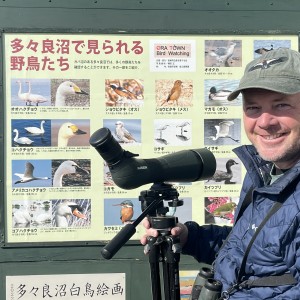
Bryan Shirley graduated from the University of Kentucky with a degree in Japanese/International Economics. He lived in Japan for 3 years when he was 20 and fell in love with the language and culture and has been guiding and birding there ever since. Besides guiding in Japan, he regularly leads tours for Japanese birding groups around the US and other countries. When not guiding he has been involved with various DWR and USFWS projects such as relocating Sage Grouse, breeding bird surveys, and bird-related projects for private environmental consulting firms. He also has volunteered his time to serve as president of Utah County Birders and organizes the annual Audubon Christmas Bird Counts for Provo and Payson, Utah where he currently resides. He currently is a member of the Utah Bird Records Committee.
Other trips with Bryan Shirley
-
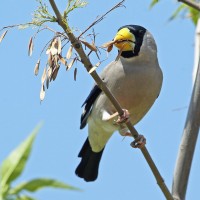 Japan in Spring: From the Ryukyu Islands to Hokkaido A private tour for friends of Carlos Sanchez.May 29 - June 12, 2025
Japan in Spring: From the Ryukyu Islands to Hokkaido A private tour for friends of Carlos Sanchez.May 29 - June 12, 2025 -
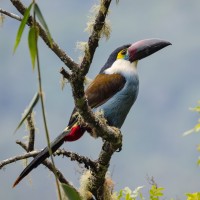 Birding from Bogota Only two spaces left!July 28 - August 3, 2025, w/Chingaza National Park extension
Birding from Bogota Only two spaces left!July 28 - August 3, 2025, w/Chingaza National Park extension -
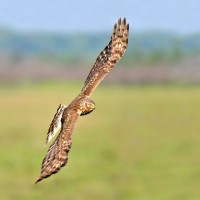 Nevada's Great BasinAugust 27 - September 3, 2025
Nevada's Great BasinAugust 27 - September 3, 2025 -
 South Africa: Birding & Wildlife Safari Only two spaces left!September 16 - 30, 2025
South Africa: Birding & Wildlife Safari Only two spaces left!September 16 - 30, 2025 -
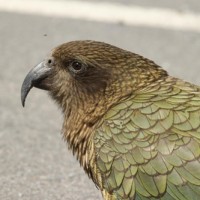 Birds & Nature of New ZealandOctober 8 - 24, 2025
Birds & Nature of New ZealandOctober 8 - 24, 2025 -
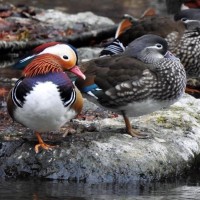 Japan Birding & Nature December 1 - 17, 2025
Japan Birding & Nature December 1 - 17, 2025 -
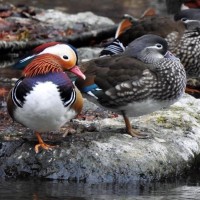 Japan Birding & Nature A private tour for friends of Andrew Mackie.January 7 - 23, 2026
Japan Birding & Nature A private tour for friends of Andrew Mackie.January 7 - 23, 2026 -
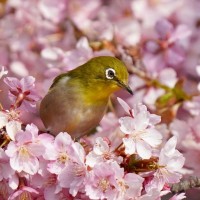 Spring in Japan: The Southern Islands Only one space left!April 1 - 14, 2026
Spring in Japan: The Southern Islands Only one space left!April 1 - 14, 2026 -
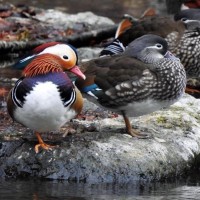 Japan Birding & Nature January 7 - 23, 2027
Japan Birding & Nature January 7 - 23, 2027
-
Essential Information +
Pace & Protocols +
Packing List +
Suggested Reading List +
Useful Links +
Photo credits: Banner: Springbok by Arne Smith on Unsplash; Giraffe by Peg Abbott; Blue and Violet-eared Waxbills by Peg Abbott; Elephants Walking Away by Peg Abbott; Dead Trees by Marcelo Novais on Unsplash; Lesser Flamingo, Bob Rodrigues Thumbnails: Jaguar (Peg Abbott), Brown-hooded Kingfisher (Greg Smith), Southern Ground Hornbill (Nina Hale), Blue Crane (Art Cimento), White Helmetshrike (Art Cimento), Northern Carmine Beeeater (NJ Stock), Giraffe (NJ Stock), Southern Yellow-billed Hornbill (Art Cimento)

















































